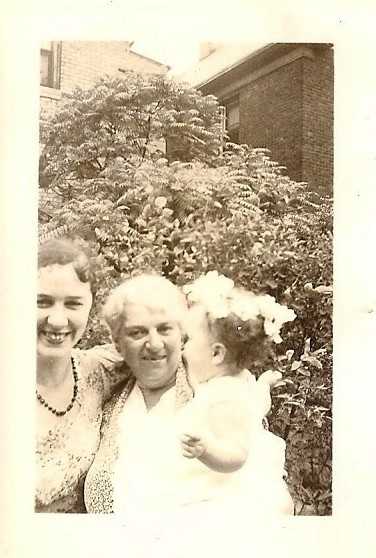Martha Beuthner was born on 8 April 1879 in Königshütte, in what was German Silesia at the time, and is now Chorzow in Poland. Her parents were Markus Beuthner and Ernestine Behnsch. On 19 September 1880 her brother Bruno was born. He was to settle in Hamburg, Germany, as a salesman, and to marry Charlotte Adolph, a non-Jewish lady.
Martha married at the age of twenty, on 20 August 1899 in Königshütte, with Nathan Norbert Scheyer. Norbert was one of the seven sons of Schaps Scheyer and Friederike Krolik, from Kempen (Kepno). He was a wholesale timber merchant. The couple settled in Breslau (Wroclaw), where they had five children: Ernst, Katherine, the twin sisters Lottie and Grete, and Mimi.
As it was for all German Jews, the Nazi takeover in January 1933 was a disaster for the family Scheyer. In 1933 Martha’s son Ernst lost his job as a curator at the Breslau Art Academy. He emigrated to the Netherlands, where he met his future wife Evelyne Rodrigues Pereira. They married in London on 31 August 1935. On 20 March 1936 they moved to Detroit in the United States. Less than three months later their first daughter was born, to be followed by a second daughter in 1942. Martha’s oldest daughter Katherine, a mother herself, was murdered by the Nazis when she was hospitalized (Katherine’s husband, son and daughter survived the war). The other three daughters all managed to escape, the twins to Switzerland and later to Israel, and the youngest, Mimi, to the United States.
Martha was less fortunate, although it could have been different. Martha and Norbert probably visited the Netherlands around 1934/1935, as both their names are on a customs document. They returned to Breslau, where Norbert died on 14 March 1936. A widow now, Martha visited her son and his family in Detroit in 1937; pictures taken during that visit show her with her granddaughter and daughter-in-law. She could have stayed with her relatives, but told them she was “unhappy in the US” and applied for a return visa to Germany. Receiving an 'official' German document, she understood that she was "safe" to return if she went directly to the particular address of a wealthy Christian family who were interested in taking her in as their chef. (Martha was an exceptional cook and had even written a cook book.) And so she returned to Germany.
With the Nazi persecution quickly becoming more severe, Martha tried to escape from Germany in May 1939, when she sailed from Hamburg on St. Louis with over 900 other Jewish refugees. To the anxiety and frustration of her son in Detroit, who had been trying to get her out of Germany, the refugees were denied access to Cuba and the United States, and the ship returned to Europe. Belgium, France, the United Kingdom and the Netherlands had agreed to allow the refugees to enter. Martha was among the 180 passengers who went to the Netherlands. She arrived at the quarantine station in Pernis, near Rotterdam, on 18 June 1939. To Dutch immigration she told she was a pension keeper, but this was not correct.
In the Netherlands, Martha lived at several addresses. On July 12th 1939 she reported at the police station in Bussum, that she had settled at the Ruthardlaan 38. According to the police report, this was a change of plans because initially she was to live with her son’s in-laws. However, on July 10th they had moved to Heemstede, but mr. Rodrigues Pereira had arranged that Martha could stay in Bussum at the house of a Dutch widow and her family. The Jewish Relief Committee and her children supported her financially, according to the police report.
It seems plausible that the ‘initial plan’ to move in with the Rodrigues Pereira’s had been made up in order to get her to Holland, where Martha had more relatives. One of Norbert’s brothers, Leopold Scheyer, his wife Nanny Ginsberg, and relatives of her had fled to the Netherlands as well; Leopold and Nanny also lived in Bussum since March 1939. Leopold had been a pharmacist in Berlin; he and Nanny had two daughters, who escaped from Germany with their families and survived the war.
Martha stayed in Bussum for half a year; in January 1940 she moved to Utrecht (Oudwijk 12 AIII), and three months later to Amsterdam. There she lived at the Merwedeplein 1a-III, from 17 April 1940 until 4 October 1941. In her house at the Merwedeplein several other Jewish refugees from Germany stayed, often only for a few weeks or months. Martha’s last known address is Michelangelostraat 53 hs, Amsterdam.
Three weeks after Martha’s arrival in Amsterdam, on May 10th 1940, Germany invaded the Netherlands. The end came in the Spring of 1943. First, her brother Bruno was arrested by the Gestapo on 19 December 1942, and brought to one the peripheral work camps at Auschwitz, the Außenlager in Bielitz. There he died on 7 May 1943. Leopold put an end to his life in March 1943, when he received the call-up for deportation. His wife Nanny was killed in the Sobibor extermination camp in Poland, on 30 April. Less than three weeks later, on 18 May 1943, Martha was sent on a transport train to the Westerbork transit camp in the East of the Netherlands. On the same day, she and over 2,500 other people were deported to Sobibor as well. All were murdered upon arrival, on 21 May 1943.
